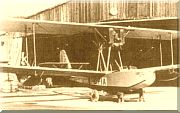| CANT 7 | |
|---|---|
 | |
| General information | |
| Type | Flying boat trainer |
| Manufacturer | CANT |
| Designer | |
| Primary user | Società Italiana Servizi Aerei |
| Number built | 34 |
| History | |
| First flight | 1924 |
The CANT 7 was a flying boat and training aircraft that was produced in Italy in the 1920s. It was a conventional biplane design with single-bay, unstaggered wings of equal span, with the single engine mounted below the upper wing. The aircraft was designed to prepare pilots for flying boat airliners, and most of the examples produced were purchased by Società Italiana Servizi Aerei for this purpose.